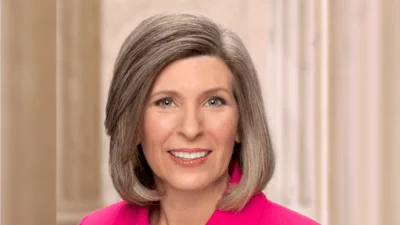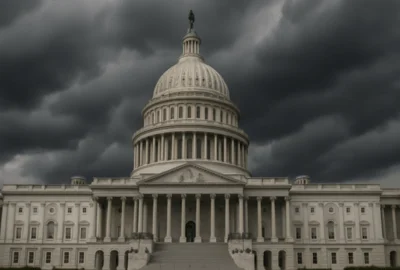Director Johns Draws on Personal Experience To Guide Equitable, Sustainable Energy Access
The team of federal employees supporting the U.S. Department of Energy (DOE) Office of Indian Energy Policy and Programs is small but mighty. In this "Meet Our Team" blog series, we introduce key staff dedicated to the Office and its mission to support tribes in pursuing their energy visions.
Wahleah Johns is the Director of the U.S. Department of Energy (DOE) Office of Indian Energy Policy and Programs and a member of the Navajo (Diné) tribe. In 2019, she was awarded the Nathan Cummings Foundation Fellowship for her work bringing solar energy to Native communities. Read on to learn about her goals working in the Office of Indian Energy.
How have your life experiences shaped your path and prepared you to serve as the director of the Office of Indian Energy?
Where to begin? It’s an honor to be in this role as the director of the Office of Indian Energy. My background is: I’m Navajo, I’m Diné, from northeastern Arizona, and how I got involved in energy work is through water. I come from a rural, remote community on the Navajo reservation where they don’t have access to electricity, and broadband is nonexistent there. You can barely get a cell phone signal. The Navajo aquifer sits below the community I’m from and you have to haul water every day. It’s ice age pristine water. You don’t have to add or take anything away from this water, you can just drink it out of the well.
Over the past, I would say, 50 years, we have seen impact and drawdown on our groundwater from the use of coal mining operations, using our groundwater to transport coal. Usually, coal resources are transported by railway, and this form of transportation was pulverizing coal and mixing it with pristine groundwater-3.3 million gallons every day. And all of this is powering cities like Los Angeles and Las Vegas, pretty much the West. To be where [it is] today wouldn’t have been possible if it weren’t for the coal and water of where I come from and the people.
So, that perspective on energy-living two miles from a coal mining operation and seeing the exporting of power to benefit cities, and yet over the hill from the operations there are many families that don’t have access to electricity or running water, basic infrastructure-that motivated me to protect our ground water and figure out strategies and policies to protect our ground water. There has to be another way to generate power that isn’t taking from our resources.
I believe that we have this beautiful light that shines on us every day that actually can bring power to people who are in need of electricity. [It] can sustain and cut emissions and create jobs, [and] bring hope to our planet that is in desperate need of climate solutions.
What motivated you to accept this leadership role?
Right now, we have estimated over 20,000 Native American homes that don’t have access to electricity. When you have electricity, you’re more productive. There are so many benefits. For me, I feel like there are solutions and that’s where I’ve been mostly focused, is the strategy and how we’re going to address energy access in the United States. We have to elevate that it’s an issue and a topic. How come we have [a] majority of these Native American families in Indian Country that don’t have access to power? How can we solve that and prioritize that? I feel like that’s been my role here, to really elevate that issue.
What do you see as the greatest challenges in tribal energy development today? The greatest opportunities?
I think the biggest challenges in Indian Country is that when it comes to clean energy, tribes are nontaxable entities. So, incentives that are out there for clean energy development are often tax incentives outside of Indian Country. We have to think through how to really gives tribes access to be able to determine what type of energy future they want and be able to participate and actually be generators of power if they want. For my role, I love to tackle challenging issues, and this is one that I really want to take on.
There are plenty of opportunities, as well. To address the energy access issue in Indian Country, it’s a coordinated effort that needs to happen with the community, with the nations, with the federal government helping, state government helping, private investors, foundations-it’s everybody. It’s a solvable issue, it just needs to be prioritized. It takes political will, and it takes collaboration of all entities coming together to address this issue and topic. I think it is solvable, it can take a few years, and it can create a lot of jobs and opportunities for tribes to be in a better place.
What strategic goals or priorities do you want to achieve or address as director of the Office of Indian Energy?
For [the] Office of Indian Energy, our focus is on addressing energy access [for] the Native American homes that don’t have access to electricity and supporting tribes going through the clean energy transition. There is so much potential and opportunity in clean energy on tribal lands, the benefits are undeniable-for our planet, for individual cost savings through efficiency, and for tribal energy sovereignty and resiliency.
[Also, we want to leverage] tribal colleges and universities and use them as the model of a transition effort toward 100% renewable energy. There is a lot of organizing that is needed when you do that, and I think it’s a learning opportunity. I see them as the microcosm of what could be possible in communities at a larger scale, [and] in cities. If they are able to figure out energy load in the school, they can help their communities.
The other area I’m excited about is beefing up our deployment program with more money so that we can fund more projects that are exciting in Indian Country. The Bipartisan Infrastructure Law (BIL) is a once-in-a-generation investment in our nation's infrastructure, competitiveness, and communities. BIL will support clean energy deployment by funding state, local, and tribal programs and projects that increase access to energy efficiency to save money for families, businesses, and communities, and help achieve our clean energy goals and accelerate job growth. We’re really excited for that.
All our approaches have been pretty holistic when it comes to supporting projects. It automatically builds capacity internally for the tribes, and so hopefully that turns into more interest in applying renewable energy to their community, or possibly scaling to sell power to other markets, or create a tribal utility. I think that is the impact our work has had over 10 years, that just keeps growing.
In what important ways do you think the Office of Indian Energy can help advance the current administration's priorities?
The Office of Indian Energy, the design and the statute, is pretty fascinating, because it allows our office to help support tribes in project development, no matter where they are in the project stages. I’m excited about the policy, and how Indian Country is going to be included in this $62 billion Bipartisan Infrastructure Law and be able to apply for some of these grant funds that will have huge benefits in their communities.
This administration has been really focused on equity. We have the Justice40 Initiative, which requires federal agencies to deliver at least 40 percent of the overall benefits from federal investments in climate and clean energy to disadvantaged communities. This administration is also really focused on strengthening our federal relationships with tribes, and upholding our trust responsibility. I think those two aspects [are] important and [is what we are working on].
With the Justice40 Initiative, I feel the Office of Indian Energy has been demonstrating that for a long time. You could almost think of the Office of Indian Energy as “justice 100," because 100% of our investment goes to tribal projects that make them more climate resilient. We see tangible, immediate results that benefit the people and communities, that makes them more self-sufficient in generating their power, that builds capacity, [and] that creates jobs.
For tribes, the values of sovereignty and self-determination [are so important]. If a project is designed right for the community, it can demonstrate that self-reliance and self-determination and sovereignty that tribes hold close. We want them to own their power, we want them to learn to manage their power, and that gets me excited because that’s what tribes are about-having the tools and resources and support. I think that’s what this administration is bringing, and something that I’m trying to bring.
When you have the opportunity to talk with tribal leaders, what is the one thing you feel is most important for them to know about what the Office of Indian Energy does?
My message to tribal leaders and communities is that we are here and ready to support. These opportunities are exciting because the values and goals that tribes have-on culture, land, water-this administration and our office have been providing these resources that are aligned with our cultural values, community values, and nation’s values. [We] want to be of service. We are here, and at no cost you can ask us for technical assistance. We have great engineers, and people that can help with technical and financial analysis. If you’re thinking about project planning, we have partners and contractors that specialize in strategic energy planning. Wherever you [are] with your plans and thinking, come talk to us and we can connect you to some of the opportunities.
What is your vision for the future of energy in Indian Country?
I think in 10 years, the Office of Indian Energy is going to have more resources and programs that are more visible in different regions and pockets of Indian Country that also specialize in small-scale, residential, and large projects. I think that there is going to be great policy built around Indian Country, around the caretaking of Mother Earth.
I get emotional. I’m worried about our planet mostly, because [we’ve seen] for so many years, the degradation of sacred places, waters, and land that are really special, and that all could have been avoided. I would love to see clean energy and renewable energy be the uniter of our globe, demonstrating how we can build equity into everything.
We have learned so many lessons from projects that have gone bad, like my backyard, where I hope our ground water is going to continue to my future generations. We’ve learned these lessons, we hear the stories. But how can we do it much different and much better than the legacy energy projects? That’s our task now in this administration and this time to demonstrate what that looks like; that it’s equitable, and that it’s not just benefiting a few, and we are accountable to our actions.
Source: U.S. Dept. of Energy, Office of Indian Energy Policy and Programs









